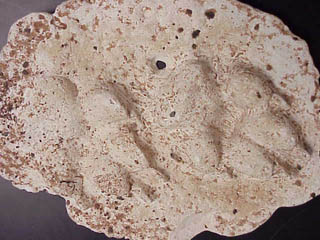
Photo (c) PSolfest, 1999

Photo (c) PSolfest, 1999
SIZE
Domestic dogs come in many shapes,
sizes, and colors. They range from the tiny Chihuahua to a huge Great Dane.
Timber wolves, however, are generally the same size throughout the world.
The timber wolf is the largest member of the canine family. The typical
wolf stands 26" to 32" tall and are 4' to 6' long, not including tail length.
Typically females are smaller than males.
One way to tell the difference between wolves and coyotes is size. A wolf is nearly twice as large a s a coyote. A coyote is around one and a half feet tall, while a wolf is about two and a half feet. Coyotes weigh around 25 to 40 pounds, compared to a wolf's weight of 60-100 pounds.
WEIGHT
Most adult wolves weigh between
60 and 80 pounds, with females weighing less than the males. It is unusual
for a wolf to weigh more than 100 pounds. Wolves have a muscular, lean
narrow chest, unlike the rounded "barrel" chest of a dog.
LEGS AND FEET
Wolf legs are long, much longer
than dog legs, allowing them to take longer steps and to run better.
They have larger feet averaging, between four and five inches long, with
non retractable claws. Their front feet are larger than their back feet.
They have five toes on their front feet and four on their rear. Like dogs,
they run on their toes, lengthening their legs, and making it possible
for them to run faster. Some have compared it to running on stilts. As
wolves walk, they usually place their hind foot in the track left by the
front foot, thus making their tracks appear as a straight line. This is
one way to distinguish wolf tracks from those of dogs who tend to "zig-zag"
as they walk.
It is common for a wolf to
cover twenty miles overnight on a hunt. The farthest recorded distance
in a twenty four hour period was 125 miles by a wolf being chased by hunters.
Wolves travel at a five mile per hour trot. In chases, the wolf can reach
speeds of between 28 and 40 miles per hour for up to 20 minutes.

Cast of wolf prints from Beaver Creek Reserve Collection. Photo (c) PSolfest 1999 |

An actual size wolf print is 41/2". Compare your hand size to the print of the wolf. |
AGE
Wolves can live to be thirteen
years old in the wild, but as is true of all animals in the wild, life
can be very harsh and death (mortality) rates are high. The first
year is the most difficult. Usually only about a half of the pups born
in a year survive to their first birthday. Wolves suffer from disease such
as canine parvovirus, canine distemper, and heart worm, the same kinds
of illnesses that dogs can get. Dispersing wolves also suffer
higher mortality rates, but once they have established a territory, their
chances of survival are much better. The average adult lives to six or
seven years of age.
The biggest factor in wolf mortality is humans - illegal shooting, illegal trapping, and being hit by cars. Studies of the deaths of the wolves in Wisconsin that have been radio collared show that 60% die from human causes. Thus if wolves are to survive in Wisconsin, three conditions must exist: they need an adequate supply of prey such as deer, hares and beaver; they need access to large areas of habitat where they will be away from human danger; and they need people to understand the wolf and its habits and to possess a willingness to coexist.